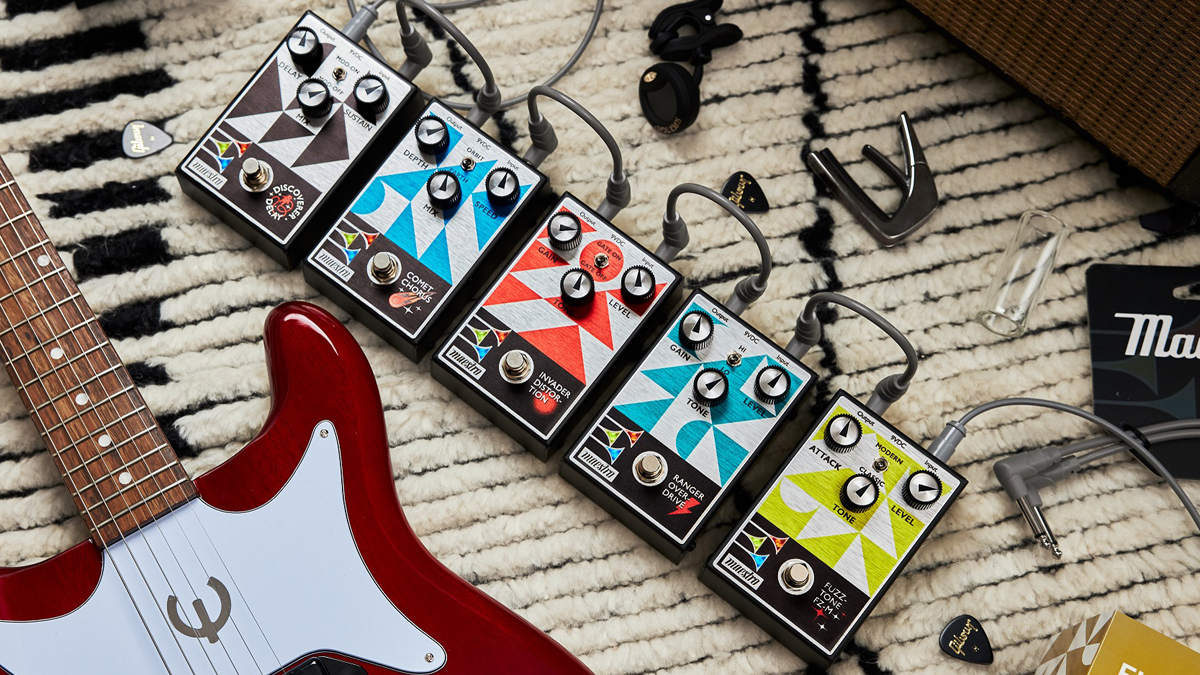
When Gibson dropped a clip teasing the return of Maestro – the pedal brand behind the world-famous Fuzz-Tone FZ-1 – we speculated that the iconic pedal builder was set to release an reinvented version of the classic fuzz pedal.
Well, it turns out Gibson is reviving Maestro for not one, but five all-new effects pedals, chief among which is a redesigned Fuzz-Tone FZ-M.
Heading up the Maestro Original Collection, the FZ-M will be joined by the Ranger Overdrive, Invader Distortion, Discover Delay and Comet Chorus.
An overview of the pedals reveal uniformity in their functional design – each features three control knobs and a central voice-changing toggle switch – and aesthetic appearance, which is headed up by three illuminating Maestro-branded bugle lights.
That’s not all, though: Gibson has announced a second batch of five pedals will join the burgeoning Master Original Collection later this year, with a Maestro Custom Shop Collection – made up of ultra-limited pedals built to the precise specs of the originals – also currently in the works.
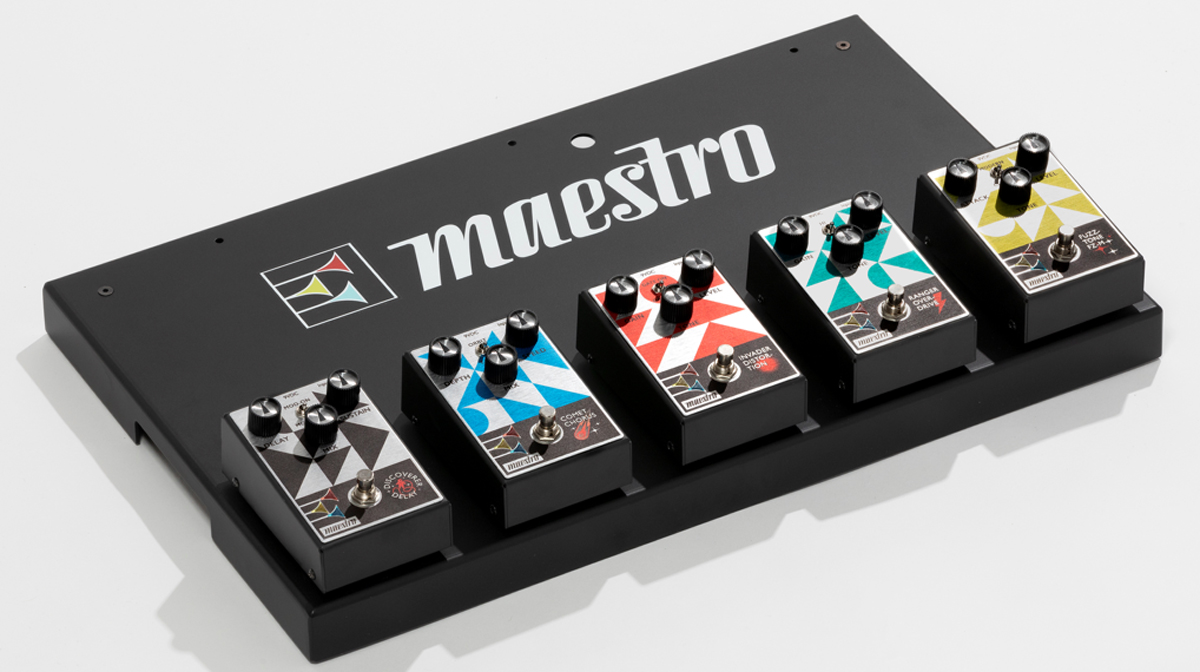
Commented Craig Hockenberry, Director of Engineering, Gibson Brands, and Lead Designer of Maestro, “I don't think there’s any ceiling in terms of what Maestro can do. Given Maestro’s history and legacy, it has certainly earned the right to play anywhere in the effects world.”
“When it comes to Maestro in 2022, all you have to do is use your imagination,” he added. “That’s where Maestro will go and where Maestro will be.”
Get The Pick Newsletter
All the latest guitar news, interviews, lessons, reviews, deals and more, direct to your inbox!
The return of Maestro will no doubt excite pedal fans, given its mythical status. After the flagship FZ-1 – designed by Glenn Snoddy and Revis V. Hobbs – debuted in 1962, Maestro went on to create a range of high-profile pedals.
Such pedals include the Boomerang BG-2 Wah, designed by Richard Mintz in the ‘70s, as well as a range of subsequent Fuzz-Tone reissues.
Read on to find out about Gibson's new line of Maestro pedals – all of the below are available for $149, with the exception of the Discoverer Delay, which lists for $159.
Maestro Fuzz-Tone FZ-M
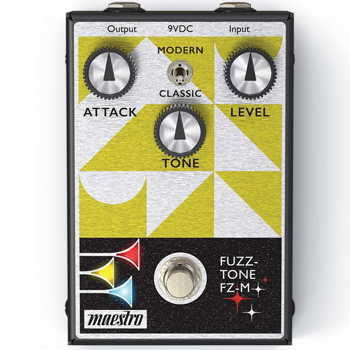
We have to start with the FZ-M. Based on the same pedal that paved the fuzz-laden path for all other pedals, the modernized Fuzz-Tone boasts a period-accurate all-analog design in a bid to capture Keith Richard’s iconic I Can’t Get No (Satisfaction) tone.
However, alongside the FZ-1-inspired fuzz is a newly designed sound, with the FZ-M’s two-in-one functionality also promising a thicker, more “modern” fuzz tone. Accessed via the Classic or Modern modes, each voice is tweaked by way of Attack, Tone and Level controls.
In practice, the knobs are fairly self-explanatory: Attack controls the fuzz sound and Level adjusts the output, while Tone aims to take the overall sound from bright, raspy timbres to warm, woolly fuzzes.
Maestro Ranger Overdrive
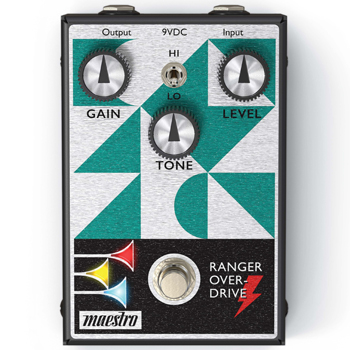
Next up is the Ranger Overdrive, said to be inspired by the “world’s most cherished vintage tube amps”. The all-analog overdrive pedal comes equipped with a Hi/Lo toggle switch – used to change between amp-like overdrives and touch-sensitive cleans – as well as knobs for Gain, Tone and Level.
Said to be usable as a boost pedal to dial up the grit and dirt of your amp, as well as a delicate “always-on” warming effect, the Ranger Overdrive also features the three Maestro bugle lights, which light up when the true bypass switch is toggled.
Maestro Invader Distortion
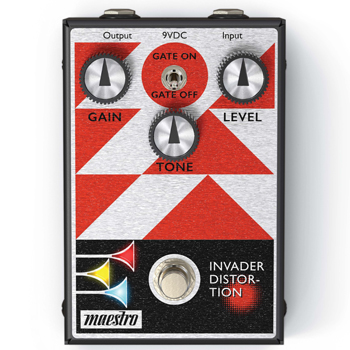
The above are joined in the gain department by the Invader Distortion. Again, you’ll find nothing but analog components under the hood of this pedal, which is described by Gibson as a “modern distortion pedal with an aggressive, dominant sonic character”.
In this case, the toggle switch taps into a built-in noise gate, which can be adjusted by way of an internal trim pot that controls the pedal’s noise threshold. Elsewhere, there are controls for Gain, Tone and Level.
Maestro Comet Chorus
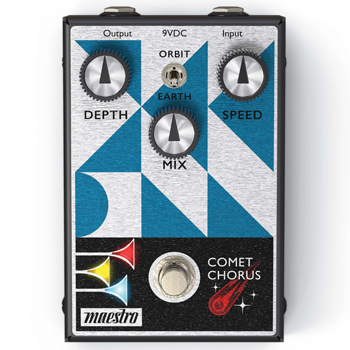
The Maestro Comet Chorus harnesses analog bucket brigade device technology and versatile switching in a bid to deliver a spectrum of sonic versatility. Tones promised include the optimized, shimmering effect of Earth mode.
Flip the toggle, and Orbit mode seeks to introduce some rotary speaker-inspired amplitude modulation into the mix. Overarching controls include Depth, Mix and Speed knobs, while an internal trim pot dictates the overall Orbit effect level.
Maestro Discoverer Delay
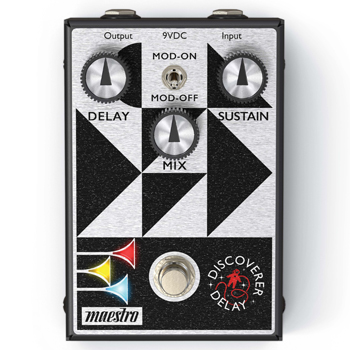
Last but not least is the Discoverer Delay. Once again, bucket brigade technology crops up here, and is used in a bid to deliver classic delay sounds. Delay time, controlled via the appropriate knob, ranges from 20ms to 600ms, and is complemented by Sustain and Mix knobs.
For the Discoverer Delay, the toggle engages a built-in modulation effect that taps into a range of tape-like flutters and heavy pitch-shifting. This Mod-On effect can be further tweaked via two internal trim pots that adjust the Rate and Width of the modulation.
To find out more on the new range, head over to Maestro Electronics.

Matt is the GuitarWorld.com News Editor. He has a Masters in the guitar, a degree in history, and has spent the last 16 years playing everything from blues and jazz to indie and pop. When he’s not combining his passion for writing and music during his day job, Matt records for a number of UK-based bands and songwriters as a session musician.
“Jimi was staying at a hotel in Times Square. He had his hair set in pink curlers and we would just talk band drama”: Electro-Harmonix founder Mike Matthews on befriending Hendrix, booking Chuck Berry and the birth of pedal culture
“Our answer to everything players have asked for and more”: Neural DSP’s Nano Cortex had one major drawback – but now it’s been addressed with a huge free firmware update that takes on Kemper and TONEX











